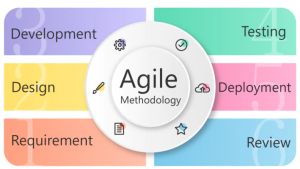Key Takeaways:
- Digital transformation is crucial for startup success in today’s tech-driven world
- Strategies include cloud adoption, data analytics, AI integration, and user-centric design
- Agile methodologies and cybersecurity are fundamental to growth and protection
- Mobile-first approach and digital marketing are essential for reaching modern consumers
- Building a scalable infrastructure and fostering a digital culture ensure long-term success
In the fast-paced world of startups, staying ahead of the digital curve isn’t just an advantage—it’s a necessity. Whether you’re a tech whiz or just starting to dip your toes into the digital ocean, these 10 essential digital transformation strategies will help your startup thrive in 2024 and beyond. Let’s explore how you can turn your great ideas into a successful, tech-savvy business!
1. Embrace Cloud Computing: Your Digital Swiss Army Knife
Think of cloud computing as your startup’s digital Swiss Army knife. It’s versatile, powerful, and can help you tackle almost any tech challenge.
- Cost-Effective: Pay only for what you use, saving precious startup capital
- Scalable: Grow your digital infrastructure as your business expands
- Accessible: Work from anywhere, anytime—perfect for modern, flexible teams
- Collaborative: Share and edit documents in real-time with your team
“The cloud is not just about saving money, it’s about speed and agility.” – Marc Benioff, CEO of Salesforce
Pro Tip: Start with basic cloud storage and gradually adopt more advanced services like cloud-based CRM or project management tools as your startup grows.
- Leverage Data Analytics: Turn Information into Innovation
Data analytics is like having a crystal ball for your business. It helps you understand your customers, predict trends, and make smarter decisions.
- Customer Insights: Understand what your users really want
- Predictive Analysis: Anticipate market trends and customer behavior
- Performance Tracking: Measure your startup’s progress with real data
- Personalization: Tailor your products or services to individual user needs
Getting Started: Begin with free tools like Google Analytics for your website. As you grow, consider more advanced platforms like Tableau or Power BI.
- Adopt Artificial Intelligence (AI): Your Digital Brain
AI isn’t just for tech giants anymore. It’s a powerful tool that startups can use to automate tasks, enhance customer experiences, and drive innovation.
- Chatbots: Provide 24/7 customer support without breaking the bank
- Predictive Maintenance: Anticipate issues before they become problems
- Personalized Recommendations: Boost sales by suggesting products users love
- Process Automation: Free up your team to focus on creative and strategic tasks
AI in Action: Consider implementing a simple chatbot on your website to handle basic customer queries, or use AI-powered tools to automate your social media posting schedule.
- Focus on User-Centric Design: Put Your Customers First
User-centric design is all about creating products and services that your customers will love to use. It’s like being a mind reader, but with more research and less guesswork.
- User Research: Understand your customers’ needs, wants, and pain points
- Prototyping: Test your ideas quickly and cheaply before full development
- Usability Testing: Get real user feedback to improve your product
- Iterative Design: Continuously improve based on user insights
“Design is not just what it looks like and feels like. Design is how it works.” – Steve Jobs
Design Tip: Start by creating user personas—fictional characters that represent your ideal customers. Use these to guide your design decisions.
- Implement Agile Methodologies: Stay Flexible and Fast
Agile methodologies help your startup move fast and adapt quickly. It’s like being a surfer, riding the waves of change instead of being swept away by them.
- Sprints: Work in short, focused bursts to deliver value quickly
- Flexibility: Adapt to changes in the market or customer needs
- Collaboration: Foster teamwork and communication
- Continuous Improvement: Regularly reflect and adjust your processes
Agile in Practice: Start with daily stand-up meetings where team members share progress and challenges. Use tools like Trello or Jira to manage your agile workflow.
- Prioritize Cybersecurity: Protect Your Digital Assets
In the digital world, cybersecurity is like having a strong lock on your door. It protects your business, your data, and your customers’ trust.
- Data Encryption: Keep sensitive information safe from prying eyes
- Regular Updates: Keep all software and systems up-to-date
- Employee Training: Your team is your first line of defense
- Incident Response Plan: Be prepared for potential security breaches
Security Starter: Implement two-factor authentication for all your business accounts and use a password manager to ensure strong, unique passwords across your organization.
- Develop a Mobile-First Strategy: Reach Customers Where They Are
With most internet traffic coming from mobile devices, a mobile-first strategy is crucial. It’s like speaking your customers’ language—the language of smartphones and tablets.
- Responsive Design: Ensure your website looks great on all devices
- Mobile Apps: Consider developing a dedicated app for your service
- Mobile Payment Options: Make it easy for customers to buy on-the-go
- Location-Based Services: Use mobile technology to provide personalized experiences
Mobile Tip: Use Google’s Mobile-Friendly Test to check if your website is optimized for mobile devices. If not, make it a priority to update your design.
- Invest in Digital Marketing: Spread the Word
Digital marketing is your megaphone in the noisy online world. It helps you reach the right people with the right message at the right time.
- Content Marketing: Create valuable content to attract and engage customers
- SEO: Optimize your online presence for search engines
- Social Media Marketing: Build relationships and engage with your audience
- Email Marketing: Nurture leads and keep customers coming back
Marketing Starter: Begin with a blog on your website, sharing helpful content related to your industry. Use social media to promote your posts and engage with your audience.
- Build a Scalable Infrastructure: Prepare for Growth
A scalable infrastructure is like building a house with room to grow. It ensures your startup can handle success without buckling under pressure.
- Cloud-Based Solutions: Use services that can grow with your business
- Microservices Architecture: Build your application as independent, scalable services
- Load Balancing: Distribute traffic evenly across your servers
- Automated Scaling: Use tools that adjust resources based on demand
Scaling Tip: Start with cloud services that offer easy scaling options, like Amazon Web Services (AWS) or Google Cloud Platform.
- Foster a Digital Culture: Embrace the Digital Mindset
A digital culture is about more than just using technology—it’s about thinking digitally. It’s like teaching your whole team to speak the language of innovation.
- Continuous Learning: Encourage ongoing digital skills development
- Innovation Mindset: Create an environment where new ideas are welcome
- Digital Leadership: Lead by example in adopting new technologies
- Cross-Functional Collaboration: Break down silos between departments
“Culture eats strategy for breakfast.” – Peter Drucker
Culture Building: Start a weekly “tech talk” where team members can share new digital tools or techniques they’ve discovered.
Conclusion: Your Digital Transformation Journey Starts Now
Digital transformation isn’t a one-time event—it’s an ongoing journey. By implementing these 10 strategies, your startup will be well-equipped to navigate the digital landscape, adapt to change, and seize new opportunities as they arise.
Remember, you don’t have to tackle everything at once. Start with the strategies that align best with your current goals and gradually implement others as you grow. The key is to start your digital transformation journey today and keep evolving.
Which of these strategies resonates most with your startup’s needs? Are there any you’re already implementing? Share your thoughts and experiences in the comments below—let’s learn from each other and grow together in this exciting digital age!

















